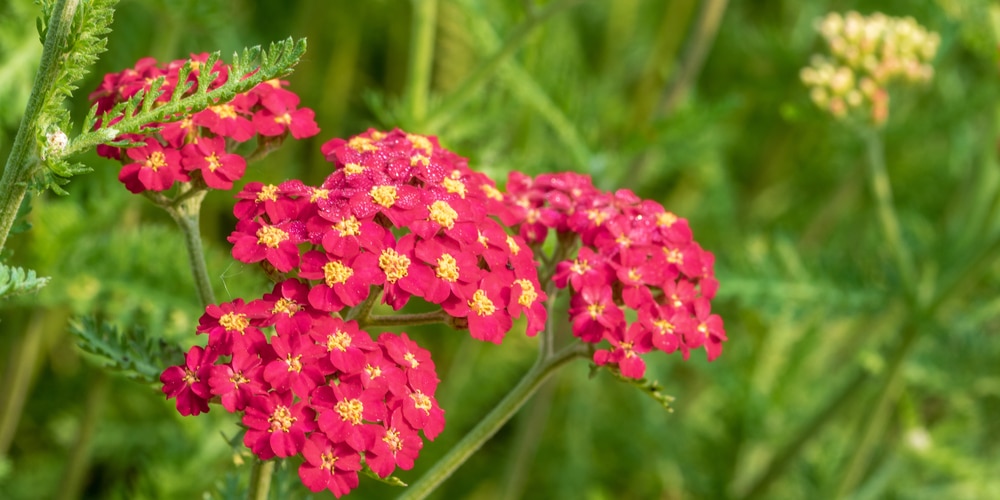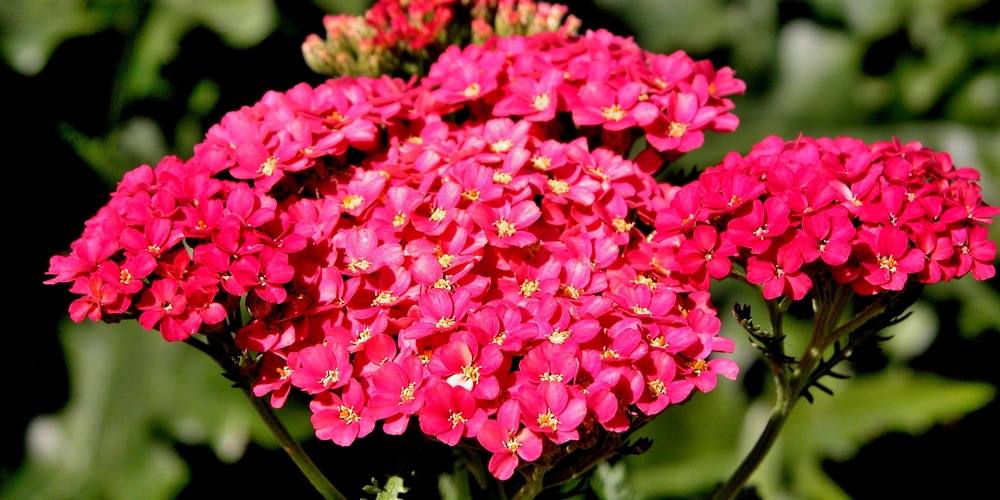Truly a sight to behold, Achillea paprika is a perennial that adds a wow factor to any garden. It’s easy to see why this plant is a favorite among gardeners: its showy flowers appear in early summer and continue until fall, providing months of color and interest. Plus, it’s low-maintenance and drought-tolerant once established.
As a hardy perennial plant, the Achillea Millefolium ‘Paprika’ can be found in most climates. It is the perfect plant for gardeners if they are looking for a low-maintenance option.
Additionally, this plant is also a good choice for those who want to attract bees and other pollinators to their garden, as this plant is alluring to these types of insects.

| Botanical Name | Achillea millefolium |
| Common Name | Yarrow, ‘Paprika’ |
| Plant Type | Perennial |
| Flower Color | Bright red petals |
| Size When Mature | 24-36 inches tall |
| Bloom Time | Late spring to summer |
| Sun Requirements | Full Sun to Mostly Sunny |
| USDA Hardiness Zones | 3 – 8 |
| Soil PH Range | 6.5 – 7.5 |
| Soil Type | Well-drained, dry to humid, loam soil |
| Water Needs | Low |
| Native Area | Europe and temperate parts of Asia |
What You Need to Know About The Achillea Paprika
Achillea millefolium ‘Paprika’ is one of the most popular yarrow cultivars on the market today. It’s easy to see why. This hardy perennial plant features bright red flowers that are sure to add interest to any garden.
It also makes a good ground cover and can be planted in rock gardens or as an edging plant. Yarrow plants grow to a height of 24-36 inches and have a spread of 12-24 inches. Its fern-like leaves topped with flat clusters of bright red petals with a yellow center are perfect in bouquets and dried arrangements.
Although it has been a favorite for gardeners and landscape artists, it is important to note that the A. Paprika can be toxic when ingested. It is also toxic to pet dogs, cats, and horses. Placing them in areas that are hard to rich by your pets and children is essential.
How to Care for The Achillea Paprika
Here’s everything you need to know about growing and caring for a thriving Achillea Paprika:
Light
The Achillea Paprika thrives in full sun, but can also tolerate partial shade. While it’s not recommended to grow this plant indoors, it can be done if you have a bright, sunny spot.
Water and Soil Needs
It is best to wait until the soil is dry to the touch before watering your yarrow. In general, they need to be watered about once a week as this plant does not like to have “wet feet” and too much water can lead to root rot.
However, during hot weather or periods of drought, Achillea Paprika may need to be watered more frequently.
Using regular tap water won’t be an issue in watering this plant.
Temperature Requirements
Although it is native to Europe, it can be successfully grown in many parts of the world. In the United States, it is hardy in USDA zones 3-8 and thrives in warm temperatures between −35 °F to 20 °F.
Although this type of plant prefers a sunny location, it can also survive in a wide range of climates – specifically from spring to hot summers.
Fertilizer
The best fertilizer to use is slow-release fertilizer in the spring. Using a slow-release fertilizer encourages blooming and helps the plant to stay strong through the summer.
Common Diseases
Millefolium Paprika is a popular ornamental plant, but it is also under threat from several fungal diseases, including botrytis mold, powdery mildew, and spittlebugs.
These diseases can cause the leaves to turn yellow and brown, and the flowers to fall off prematurely. If left untreated, these diseases can eventually kill the plant.
There are several steps that gardeners can take to prevent fungal diseases from taking hold of the plant. This includes providing adequate air circulation around the plants and removing infected leaves promptly.
The Achillea Paprika Propagation
Yarrow (Achillea millefolium) is a hardy perennial herb with thin, feathery leaves and clusters of small white flowers. It’s an easy plant to grow from stem cuttings, and it’s a good choice for beginner gardeners. The best season to propagate Yarrow from stem cuttings is in late spring or summer.
It is also best to take cuttings just after the plant has flowered. Cuttings should be taken from healthy, vigorous plants that are not too woody.
Using sharp pruning shears, remove a 4-6 inch section of stem, making sure to include several sets of leaves. Once done, dip the cut of the stem in a rooting hormone gel or powder. Don’t forget to plant in a pot filled with moistened potting mix.
Cover the pot with plastic wrap or a humidity dome to create a mini greenhouse. Place the pot in a bright, warm location out of direct sunlight. Keep an eye on the soil moisture, and water as needed to keep it moist but not soggy.
After 4-6 weeks, you should see new growth emerging from the cuttings. Once this happens, you can remove the plastic cover and begin watering as usual.
Related article: Red Flowers in Texas
